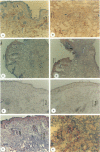Abstract
The skin cellular immune response of BALB/c mice was examined during three successive infestations with nymphal Ixodes ricinus ticks. An immunohistochemical analysis of skin cryostat sections 72 hr post-tick attachment revealed that CD4+ T cells outnumbered CD8+ T cells in all infestations. The CD4+:CD8+ T-cell ratio was 2.2:1 in the primary infestation, then increased to 3.2:1 and 4.7:1 in the secondary and tertiary infestations. No B lymphocytes (CD45R) were detected in the skin of control and infested mice. A positive staining of intercellular adhesion molecule-1 (ICAM-1) on vascular endothelial cells, dendritic cells and some other mononuclear cells was observed in the dermis. Also, a strong positive staining of Ia antigens on dendritic cells and infiltrated mononuclear cells was noted. The staining pattern was more intense and positive cells increased in number in the skin of re-infested mice compared to the primary infestation. In addition, cells such as epidermal keratinocytes, dermal dendritic cells and infiltrated mononuclear cells positive for the 'pro-inflammatory' cytokines interleukin-1 alpha (IL-1 alpha) and tumour necrosis factor-alpha (TNF-alpha) were localized in the skin of infested mice, as detected at the mRNA level by in situ hybridization and at protein level by immunostaining with antibodies. These results suggest that an antigen was presented to infiltrating T lymphocytes which then became activated. This event may explain the cutaneous delayed-type hypersensitivity previously described in tick-infected BALB/c mice. Importantly, this cutaneous reaction was not sufficient to protect the mouse against tick re-infestation. Furthermore, ICAM-1 could mediate, at least in part, the extravasation of inflammatory cells into the skin of infested mice.
Full text
PDF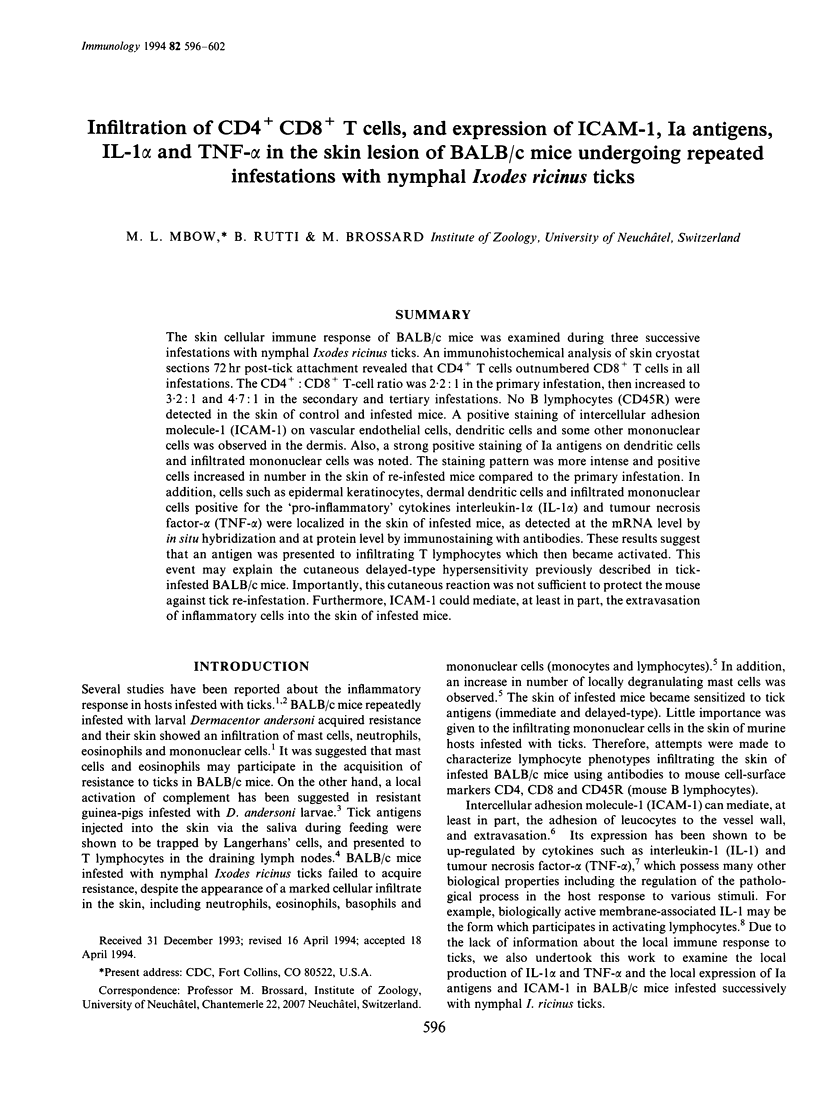
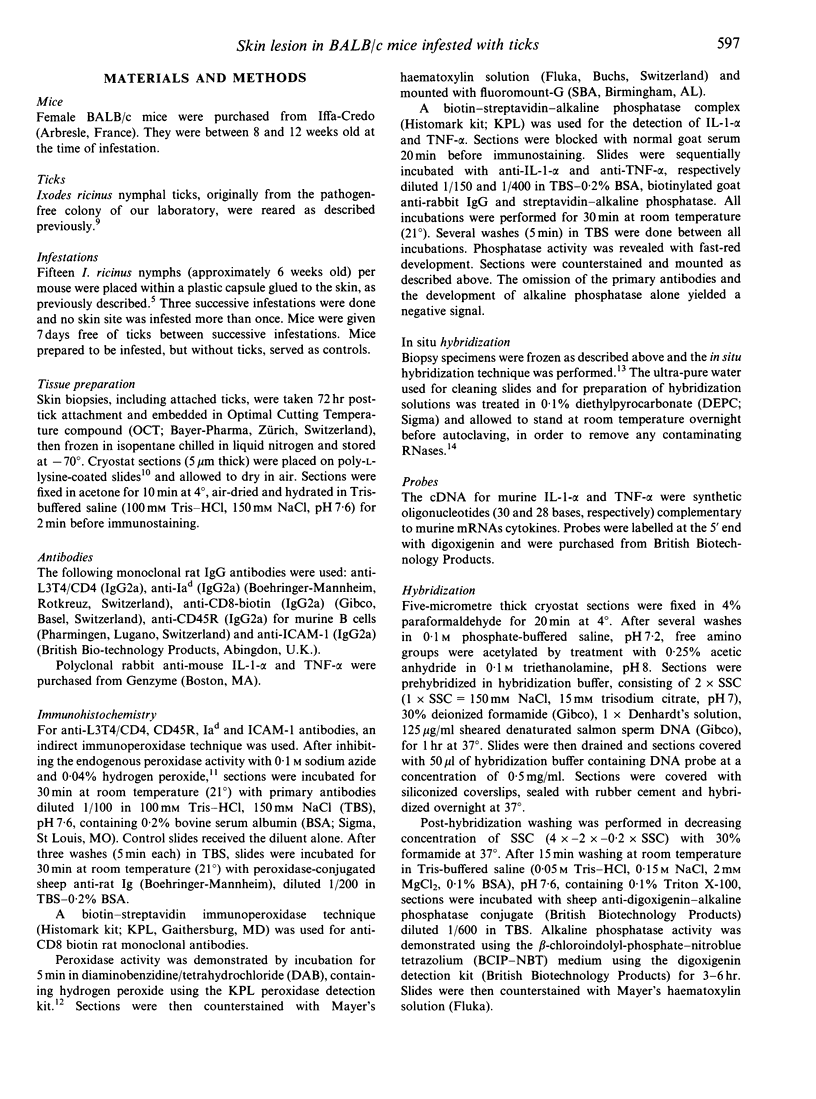
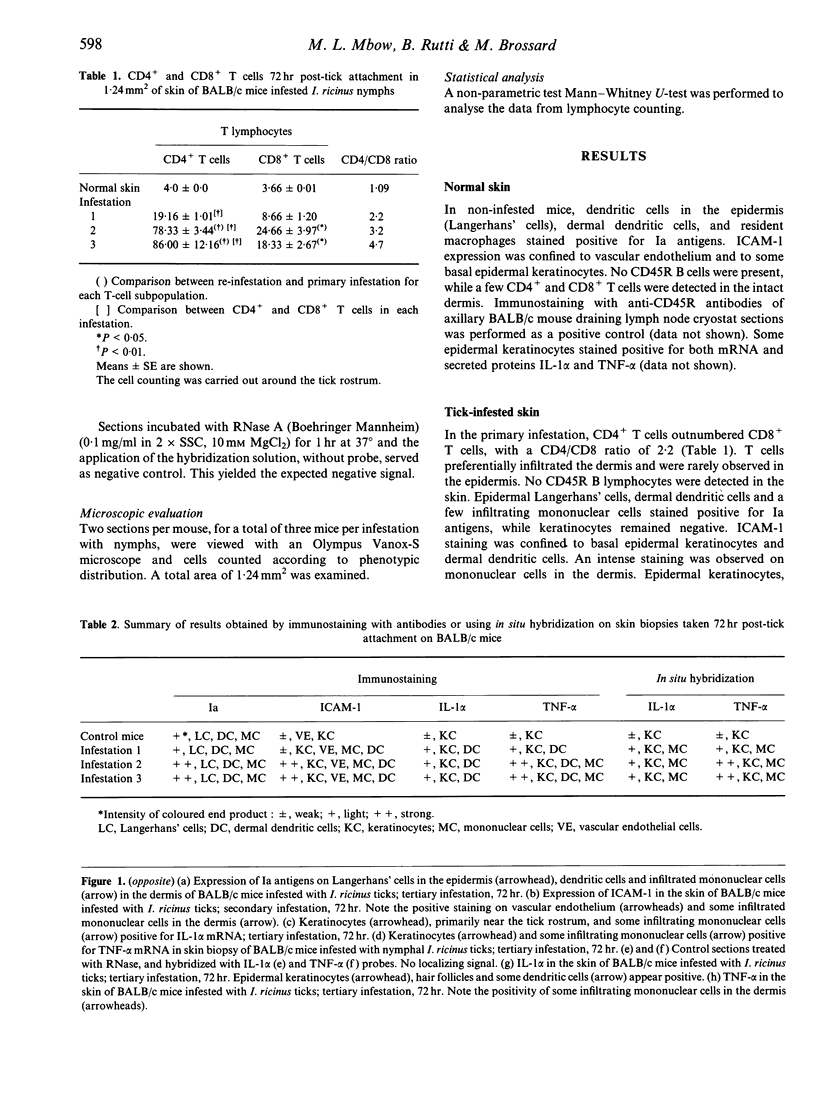
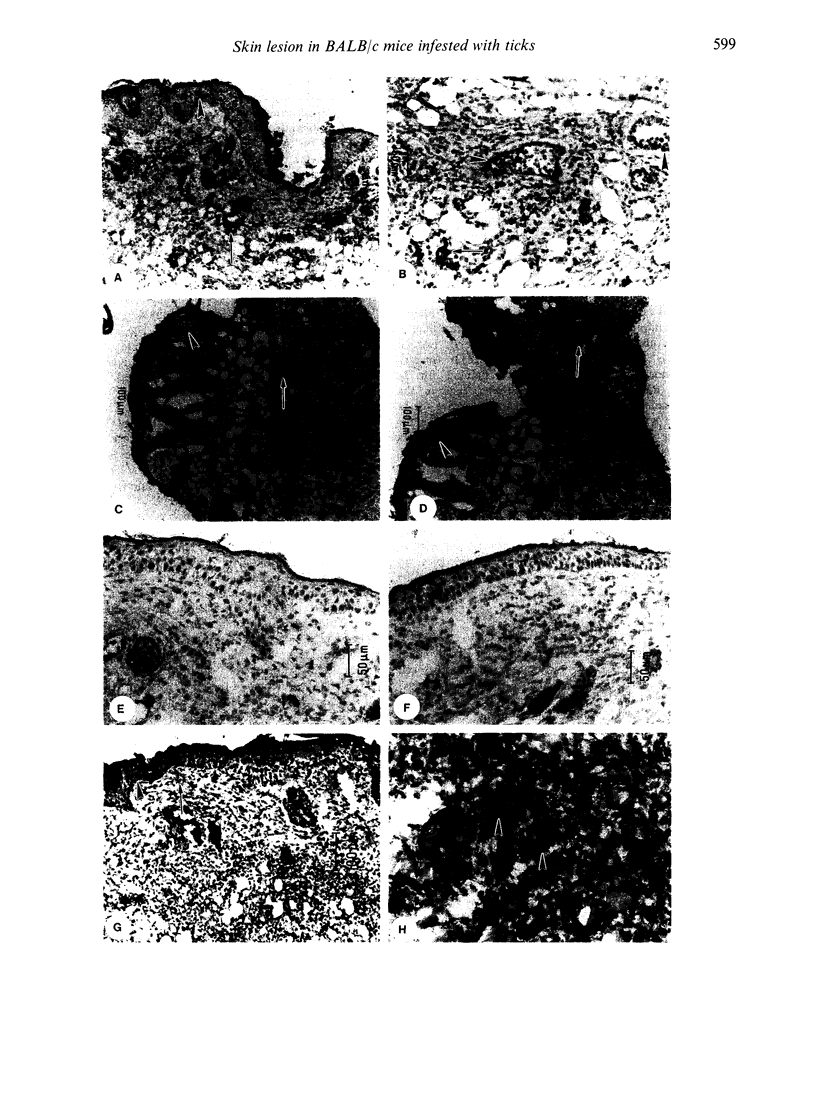
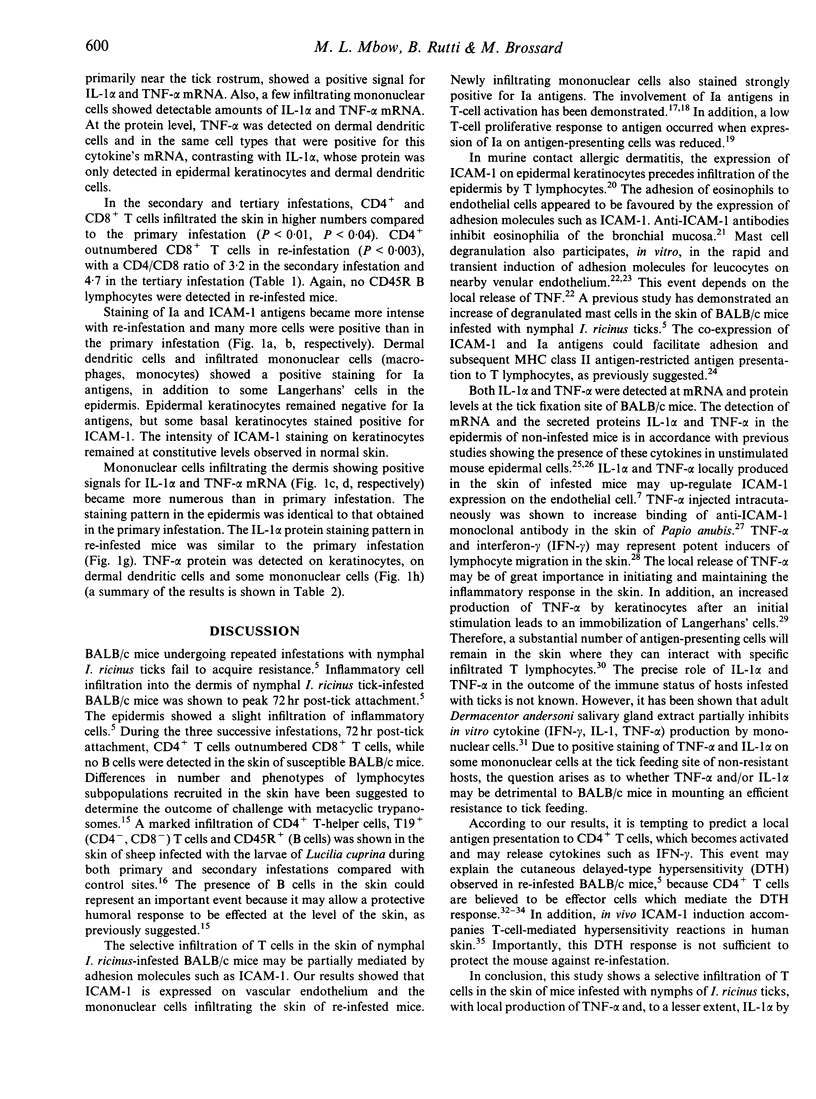
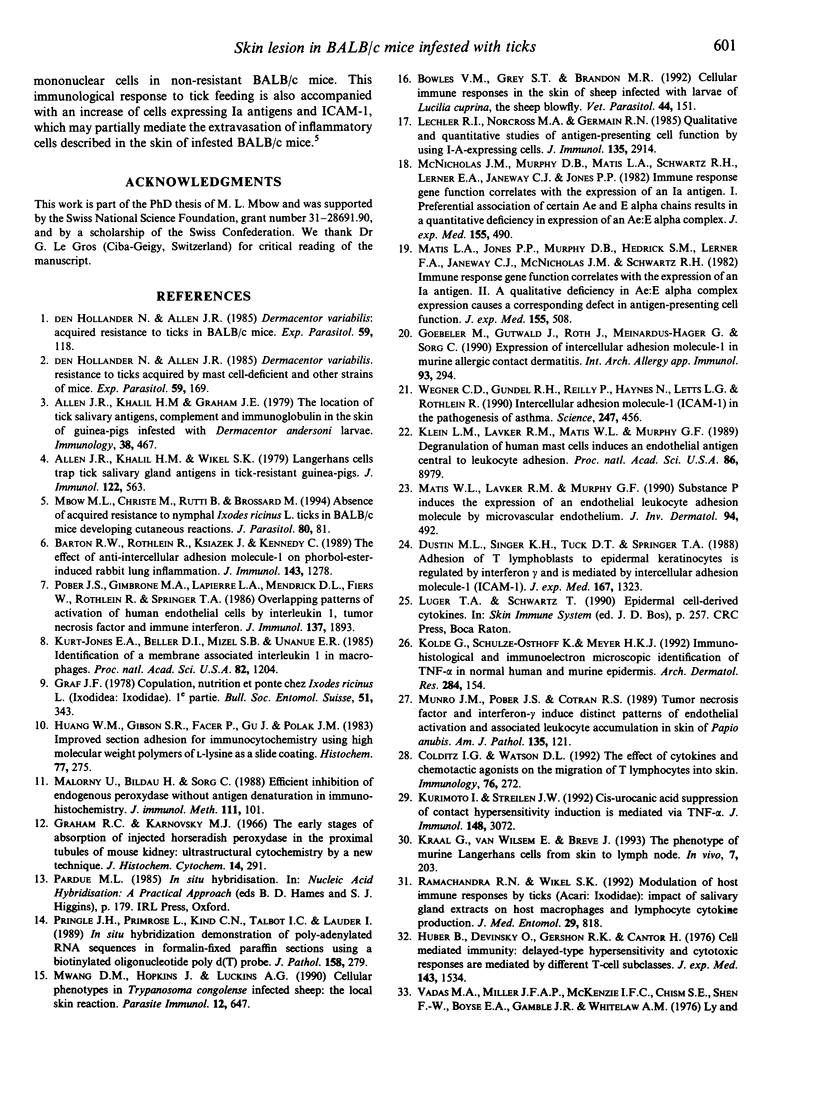

Images in this article
Selected References
These references are in PubMed. This may not be the complete list of references from this article.
- Allen J. R., Khalil H. M., Graham J. E. The location of tick salivary antigens, complement and immunoglobulin in the skin of guinea-pigs infested with Dermacentor andersoni larvae. Immunology. 1979 Nov;38(3):467–472. [PMC free article] [PubMed] [Google Scholar]
- Allen J. R., Khalil H. M., Wikel S. K. Langerhans cells trap tick salivary gland antigens in tick-resistant guinea pigs. J Immunol. 1979 Feb;122(2):563–565. [PubMed] [Google Scholar]
- Barton R. W., Rothlein R., Ksiazek J., Kennedy C. The effect of anti-intercellular adhesion molecule-1 on phorbol-ester-induced rabbit lung inflammation. J Immunol. 1989 Aug 15;143(4):1278–1282. [PubMed] [Google Scholar]
- Bowles V. M., Grey S. T., Brandon M. R. Cellular immune responses in the skin of sheep infected with larvae of Lucilia cuprina, the sheep blowfly. Vet Parasitol. 1992 Sep;44(1-2):151–162. doi: 10.1016/0304-4017(92)90153-z. [DOI] [PubMed] [Google Scholar]
- Colditz I. G., Watson D. L. The effect of cytokines and chemotactic agonists on the migration of T lymphocytes into skin. Immunology. 1992 Jun;76(2):272–278. [PMC free article] [PubMed] [Google Scholar]
- Dustin M. L., Singer K. H., Tuck D. T., Springer T. A. Adhesion of T lymphoblasts to epidermal keratinocytes is regulated by interferon gamma and is mediated by intercellular adhesion molecule 1 (ICAM-1). J Exp Med. 1988 Apr 1;167(4):1323–1340. doi: 10.1084/jem.167.4.1323. [DOI] [PMC free article] [PubMed] [Google Scholar]
- Goebeler M., Gutwald J., Roth J., Meinardus-Hager G., Sorg C. Expression of intercellular adhesion molecule-1 in murine allergic contact dermatitis. Int Arch Allergy Appl Immunol. 1990;93(4):294–299. doi: 10.1159/000235257. [DOI] [PubMed] [Google Scholar]
- Graham R. C., Jr, Karnovsky M. J. The early stages of absorption of injected horseradish peroxidase in the proximal tubules of mouse kidney: ultrastructural cytochemistry by a new technique. J Histochem Cytochem. 1966 Apr;14(4):291–302. doi: 10.1177/14.4.291. [DOI] [PubMed] [Google Scholar]
- Huang W. M., Gibson S. J., Facer P., Gu J., Polak J. M. Improved section adhesion for immunocytochemistry using high molecular weight polymers of L-lysine as a slide coating. Histochemistry. 1983;77(2):275–279. doi: 10.1007/BF00506570. [DOI] [PubMed] [Google Scholar]
- Huber B., Devinsky O., Gershon R. K., Cantor H. Cell-mediated immunity: delayed-type hypersensitivity and cytotoxic responses are mediated by different T-cell subclasses. J Exp Med. 1976 Jun 1;143(6):1534–1539. doi: 10.1084/jem.143.6.1534. [DOI] [PMC free article] [PubMed] [Google Scholar]
- Kolde G., Schulze-Osthoff K., Meyer H., Knop J. Immunohistological and immunoelectron microscopic identification of TNF alpha in normal human and murine epidermis. Arch Dermatol Res. 1992;284(3):154–158. doi: 10.1007/BF00372709. [DOI] [PubMed] [Google Scholar]
- Kraal G., van Wilsem E., Brevé J. The phenotype of murine Langerhans cells from skin to lymph node. In Vivo. 1993 May-Jun;7(3):203–206. [PubMed] [Google Scholar]
- Kurimoto I., Streilein J. W. cis-urocanic acid suppression of contact hypersensitivity induction is mediated via tumor necrosis factor-alpha. J Immunol. 1992 May 15;148(10):3072–3078. [PubMed] [Google Scholar]
- Kurt-Jones E. A., Beller D. I., Mizel S. B., Unanue E. R. Identification of a membrane-associated interleukin 1 in macrophages. Proc Natl Acad Sci U S A. 1985 Feb;82(4):1204–1208. doi: 10.1073/pnas.82.4.1204. [DOI] [PMC free article] [PubMed] [Google Scholar]
- Lechler R. I., Norcross M. A., Germain R. N. Qualitative and quantitative studies of antigen-presenting cell function by using I-A-expressing L cells. J Immunol. 1985 Nov;135(5):2914–2922. [PubMed] [Google Scholar]
- Malorny U., Bildau H., Sorg C. Efficient inhibition of endogenous peroxidase without antigen denaturation in immunohistochemistry. J Immunol Methods. 1988 Jun 28;111(1):101–107. doi: 10.1016/0022-1759(88)90065-8. [DOI] [PubMed] [Google Scholar]
- Matis L. A., Jones P. P., Murphy D. B., Hedrick S. M., Lerner E. A., Janeway C. A., Jr, McNicholas J. M., Schwartz R. H. Immune response gene function correlates with the expression of an Ia antigen. II. A quantitative deficiency in Ae:E alpha complex expression causes a corresponding defect in antigen-presenting cell function. J Exp Med. 1982 Feb 1;155(2):508–523. doi: 10.1084/jem.155.2.508. [DOI] [PMC free article] [PubMed] [Google Scholar]
- Matis W. L., Lavker R. M., Murphy G. F. Substance P induces the expression of an endothelial-leukocyte adhesion molecule by microvascular endothelium. J Invest Dermatol. 1990 Apr;94(4):492–495. doi: 10.1111/1523-1747.ep12874665. [DOI] [PubMed] [Google Scholar]
- McNicholas J. M., Murphy D. B., Matis L. A., Schwartz R. H., Lerner E. A., Janeway C. A., Jr, Jones P. P. Immune response gene function correlates with the expression of an Ia antigen. I. Preferential association of certain Ae and E alpha chains results in a quantitative deficiency in expression of an Ae:E alpha complex. J Exp Med. 1982 Feb 1;155(2):490–507. doi: 10.1084/jem.155.2.490. [DOI] [PMC free article] [PubMed] [Google Scholar]
- Munro J. M., Pober J. S., Cotran R. S. Tumor necrosis factor and interferon-gamma induce distinct patterns of endothelial activation and associated leukocyte accumulation in skin of Papio anubis. Am J Pathol. 1989 Jul;135(1):121–133. [PMC free article] [PubMed] [Google Scholar]
- Mwangi D. M., Hopkins J., Luckins A. G. Cellular phenotypes in Trypanosoma congolense infected sheep: the local skin reaction. Parasite Immunol. 1990 Nov;12(6):647–658. doi: 10.1111/j.1365-3024.1990.tb00994.x. [DOI] [PubMed] [Google Scholar]
- Pober J. S., Gimbrone M. A., Jr, Lapierre L. A., Mendrick D. L., Fiers W., Rothlein R., Springer T. A. Overlapping patterns of activation of human endothelial cells by interleukin 1, tumor necrosis factor, and immune interferon. J Immunol. 1986 Sep 15;137(6):1893–1896. [PubMed] [Google Scholar]
- Pringle J. H., Primrose L., Kind C. N., Talbot I. C., Lauder I. In situ hybridization demonstration of poly-adenylated RNA sequences in formalin-fixed paraffin sections using a biotinylated oligonucleotide poly d(T) probe. J Pathol. 1989 Aug;158(4):279–286. doi: 10.1002/path.1711580403. [DOI] [PubMed] [Google Scholar]
- Ramachandra R. N., Wikel S. K. Modulation of host-immune responses by ticks (Acari: Ixodidae): effect of salivary gland extracts on host macrophages and lymphocyte cytokine production. J Med Entomol. 1992 Sep;29(5):818–826. doi: 10.1093/jmedent/29.5.818. [DOI] [PubMed] [Google Scholar]
- Vejlsgaard G. L., Ralfkiaer E., Avnstorp C., Czajkowski M., Marlin S. D., Rothlein R. Kinetics and characterization of intercellular adhesion molecule-1 (ICAM-1) expression on keratinocytes in various inflammatory skin lesions and malignant cutaneous lymphomas. J Am Acad Dermatol. 1989 May;20(5 Pt 1):782–790. doi: 10.1016/s0190-9622(89)70090-6. [DOI] [PubMed] [Google Scholar]
- Wegner C. D., Gundel R. H., Reilly P., Haynes N., Letts L. G., Rothlein R. Intercellular adhesion molecule-1 (ICAM-1) in the pathogenesis of asthma. Science. 1990 Jan 26;247(4941):456–459. doi: 10.1126/science.1967851. [DOI] [PubMed] [Google Scholar]
- denHollander N., Allen J. R. Dermacentor variabilis: acquired resistance to ticks in BALB/c mice. Exp Parasitol. 1985 Feb;59(1):118–129. doi: 10.1016/0014-4894(85)90064-5. [DOI] [PubMed] [Google Scholar]
- denHollander N., Allen J. R. Dermacentor variabilis: resistance to ticks acquired by mast cell-deficient and other strains of mice. Exp Parasitol. 1985 Apr;59(2):169–179. doi: 10.1016/0014-4894(85)90069-4. [DOI] [PubMed] [Google Scholar]
- van Loveren H., Meade R., Askenase P. W. An early component of delayed-type hypersensitivity mediated by T cells and mast cells. J Exp Med. 1983 May 1;157(5):1604–1617. doi: 10.1084/jem.157.5.1604. [DOI] [PMC free article] [PubMed] [Google Scholar]



